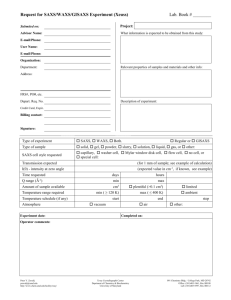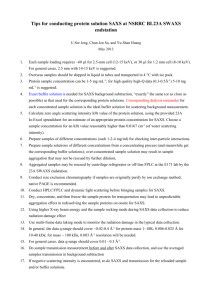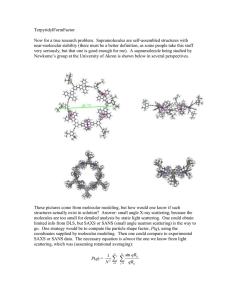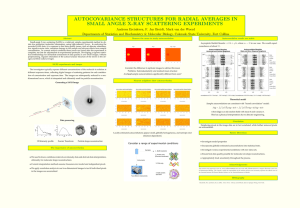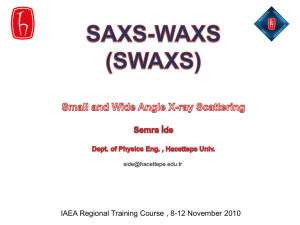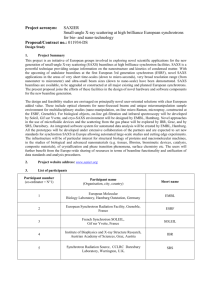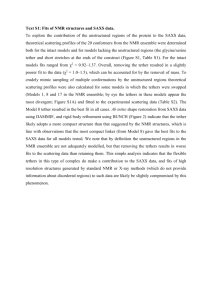complementary techniques enhance the quality and scope of
advertisement
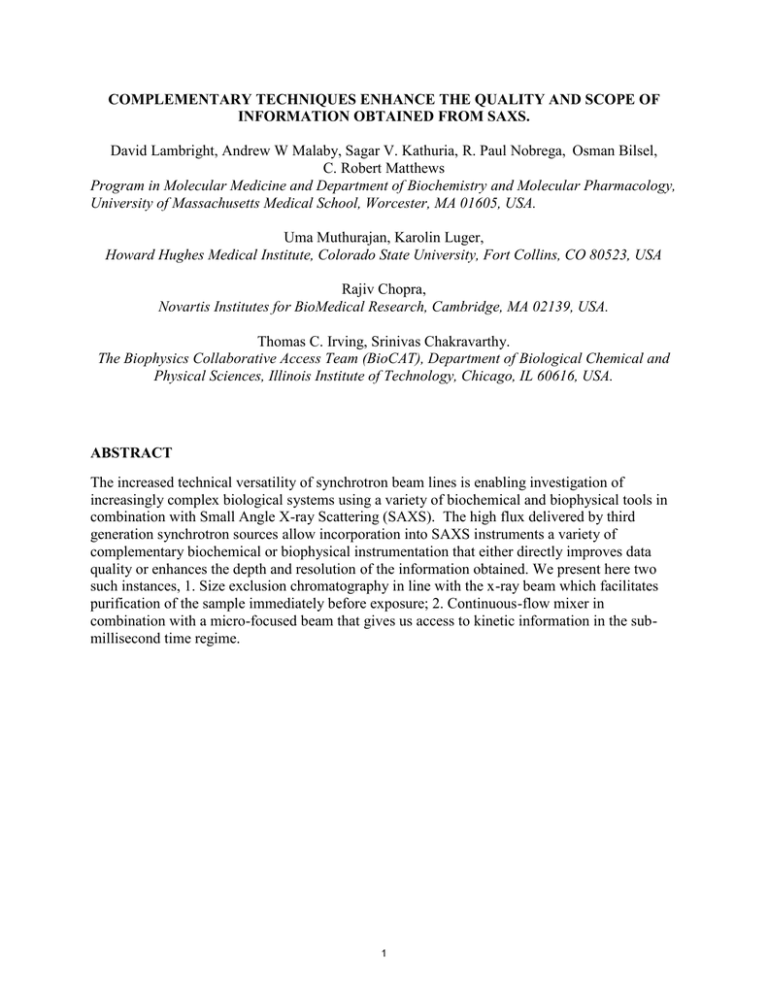
COMPLEMENTARY TECHNIQUES ENHANCE THE QUALITY AND SCOPE OF INFORMATION OBTAINED FROM SAXS. David Lambright, Andrew W Malaby, Sagar V. Kathuria, R. Paul Nobrega, Osman Bilsel, C. Robert Matthews Program in Molecular Medicine and Department of Biochemistry and Molecular Pharmacology, University of Massachusetts Medical School, Worcester, MA 01605, USA. Uma Muthurajan, Karolin Luger, Howard Hughes Medical Institute, Colorado State University, Fort Collins, CO 80523, USA Rajiv Chopra, Novartis Institutes for BioMedical Research, Cambridge, MA 02139, USA. Thomas C. Irving, Srinivas Chakravarthy. The Biophysics Collaborative Access Team (BioCAT), Department of Biological Chemical and Physical Sciences, Illinois Institute of Technology, Chicago, IL 60616, USA. ABSTRACT The increased technical versatility of synchrotron beam lines is enabling investigation of increasingly complex biological systems using a variety of biochemical and biophysical tools in combination with Small Angle X-ray Scattering (SAXS). The high flux delivered by third generation synchrotron sources allow incorporation into SAXS instruments a variety of complementary biochemical or biophysical instrumentation that either directly improves data quality or enhances the depth and resolution of the information obtained. We present here two such instances, 1. Size exclusion chromatography in line with the x-ray beam which facilitates purification of the sample immediately before exposure; 2. Continuous-flow mixer in combination with a micro-focused beam that gives us access to kinetic information in the submillisecond time regime. 1 1. INTRODUCTION SAXS of biological molecules has been a technique of limited and specialized utility for many years but is now being used much more frequently for a large variety of samples and applications. This is partly due to the wider availability of SAXS instruments on third generation synchrotron sources. The excellent beam collimation and high flux densities from such instruments yield much better signal to noise at lower sample concentrations than required for conventional sources and instruments based on older generation synchrotrons. Developments on many such SAXS facilities have focused on maximizing throughput through faster detectors and robotics [1, 2], but the same beam properties that permit high throughput also permit combining SAXS with complementary biochemical and biophysical techniques that can greatly improve the sample monodispersity and therefore the quality and interpretability of the data and time resolved measurements. Here we describe two such techniques that have been implemented at the BioCAT Beamline 18 ID at the Advanced Photon Source (APS) - Argonne National Laboratory (ANL), namely combined Size Exclusion Chromatography with SAXS (SEC-SAXS) and in-line Continuous-Flow turbulent mixing (CF-SAXS). The current state of developments and future prospects are discussed. 2. SIZE EXCLUSION CHROMATOGRAPHY COMBINED WITH SAXS (SEC-SAXS) 2.1. Why SEC-SAXS? Small angle X-ray scattering yields a variety of low-resolution information ranging from size, shape, and even internal structure of biomolecules. The quality and reliability of this information is largely dependent on the homogeneity and monodispersity of the sample, which is normally ensured by employing elaborate purification protocols that come from thorough biochemical characterization of the proteins, nucleic acids or protein – nucleic acid complexes of interest. However, despite our best efforts to bring the most homogeneous samples possible to the beam line, most samples encounter problems due to redistribution of small sub-populations into either larger soluble oligomer and aggregate forms, or into smaller sub-components due to degradation of bigger complexes, which in turn adversely affect the scattering data quality or make its interpretation difficult. It would therefore be optimal in most cases to purify the bio-molecule of interest from the contaminants using a size-exclusion chromatography (SEC) column immediately before irradiation with X-rays. The ability of SEC-SAXS to enable acquisition of reliable scattering data from otherwise non-homogeneous proteins that are susceptible to aggregation was first demonstrated at the BioCAT Beamline 18 ID in 2004 [3]. The equation I(q) α (N/V)V2particle (ρ1 - ρ2)2FF(q)S(q) shows that the scattering intensity in a SAXS experiment is directly proportional to the square of the term (V2particle) that signifies the size of the particle [4]. This means that the aggregate fraction of a protein sample, even if manifested as a relatively small peak that is eluted at the void volume of an SEC column, can potentially make large contributions to the scattering signal. This can be further compounded by the presence of nucleic acids which have a higher electron density. Nucleosome core particles for example, which consist of a histone protein core wrapped ~ 2 times by ~150 – 200 base pairs of DNA are particularly susceptible to aggregation upon storage even for relatively short durations because of the non-physiological (low ionic strength) buffer conditions used to store them after reconstitution in vitro [5]. A miniscule amount of aggregate in a sample that contains large nucleo-protein complexes such as nucleosome core particles ~ 50% of which is DNA, can 2 therefore make disproportionately large contributions to the scattering signal (Fig. 1A & B). The pure nucleosome fraction therefore needs to be, and can be, separated from the aggregate fraction (however small) immediately prior to exposure to X-rays (Fig. 1A & B). Some proteins are prone to aggregation upon long term storage, even at -80˚C. Even if a small fraction of the sample aggregates it can significantly affect the quality of SAXS data (Fig.1C & D). Figure 1. SEC-SAXS - Impact on Data Quality. (A) UV chromatogram from SEC column (Superose-6 10/300, GE Healthsciences) in-line with the beam shows that the aggregate (peak height at void volume, which is ~ 8ml for this column) is a small fraction of the sample as shown by the relative height of the peak representing the pure nucleosome fraction. (B) The SAXS sample flow cell was in simultaneously exposed for 1 second every 5 seconds. The scattering intensity is disproportionately higher for the aggregate compared to the UV peak, demonstrating the need for SEC immediately before SAXS data collection. Each point represents the integrated intensity of individual frames and they are plotted in the sequence they were acquired. (C) Guinier approximation of protein X stored at 80°C and not purified by SEC immediately before exposure to X-rays. The non-linear relation between lnI and q2 indicates aggregation and furthermore it fails to satisfy the qmax*Rg < 1.3 condition characteristic of globular proteins. (D) Guinier approximation with SAXS data collected on the same sample of protein X as in C but using a SEC-SAXS setup. The protein was loaded onto a Superdex-200 10/300 and the eluted sample was exposed to the beam for 1 second with a periodicity of 5 seconds. Selected individual exposures corresponding to the peak of the resulting chromatogram, after being reduced to the I(q) vs q one-dimensional plots were averaged before Guinier analysis. The linearity of the relationship between ln I and q2 along with the fact that qmax*Rg < 1.3 indicates that the sample is aggregate free and SEC-SAXS is the right approach for samples of this nature. Guinier analysis in both C & D was performed using Primus [6] from the ATSAS suite of programs for SAXS data analysis. There are other instances where the protein does not aggregate but tends to form oligomers in a concentration dependent manner that can only be separated by SEC (Fig. 2A). Furthermore in a recent study, the combined use of size-exclusion chromatography, refractometry, and SAXS was shown to be effective and essential in determining the structural model of a detergent coated membrane protein (aquaporin-0 surrounded by a n-dodecyl β-d-maltopyranoside corona) [7]. 3 It is therefore reasonable to posit that in most cases it is desirable to use SEC-SAXS to most efficiently ensure sample monodispersity and the highest possible data quality. 2.2. Instrumentation: The instrumentation required for SEC-SAXS, as shown in the first demonstration of the technique [3], consists primarily of an HPLC or an FPLC unit (AKTA-FPLC, GE Healthsciences, for all the experiments shown here). Several options are commercially available such as the AKTA series (GE Healthsciences) or the NGC systems (Biorad). The column outlet leads to a UV flow-cell, which in turn is usually connected to a fraction collector but in an SECSAXS setup it can be re-routed to the SAXS sample flow-cell instead. The most recent version of the apparatus used at BioCAT consists of a 1.5mm quartz capillary (with 10µm walls) that resides in a brass enclosure, which in turn is connected to a water bath for temperature regulation. A variety of gel-filtration columns with a wide range of exclusion limits are available for purifying biomolecules of different sizes from providers like GE (superdex and superpose columns) and Shodex (KW-400 and KW-800 series) (Table 1). Column size for analytical SEC varies from 3ml to 24ml, minimizing dilution of the sample and therefore ensuring high signal to noise ratio. Flow rates may vary from 0.15ml/min to 1.0ml/min therefore making collection of a full data set from a pre-equilibrated column possible in a period of ~ 5 to ~ 50 minutes. 2.3. Data Processing Developments: Raw data from a canonical SEC-SAXS experiment is a time series of one dimensional SAXS I(q) curves and a simultaneously recorded chromatogram from a UV or RI detector. While SECSAXS affords us the convenience of collecting a continuous data set with essentially a built-in concentration series, which can be extrapolated to zero, the most obvious challenges are the relatively high volume of data and the subjectivity involved in determining the appropriate procedure for buffer subtraction. Programs are being developed, which will enable automated and objective SEC-SAXS data processing. One example of such programs is a suite of novel software tools specifically conceived for SECSAXS within Ultra Scan – SOlution MOdeler (US-SOMO; http://somo.uthscsa.edu/) [8], which is an open source program that primarily calculates conformational and hydrodynamic parameters for macromolecules based on their three-dimensional atomic structures. The SECSAXS module, in principle, treats the time sequence of I(q) vs q curves as a connected series of chromatograms I(t) vs t [9]. Decomposition techniques are applied to the chromatography data and are then used in combination with physical knowledge of the SAXS experiments to separate peaks thus recreating separated I(q) vs q curves. Samples often exhibit non-baseline-resolution during SEC and sometimes a drifting baseline, which makes features such as Gaussian decomposition of non-resolved peaks and baseline correction essential. Semi-automated protocols for extrapolation of radii of gyration (Rg), the weight averaged zero scattering angle intensities (I0) and molecular mass (Mw) from Guinier plots are also available. 4 TABLE 1 Commercially Available Size-Exclusion Columns Suitable for SEC-SAXS Column Name Exclusion Limit (Mr) Recommended Flow Rate (ml/min) Theoretical Plates* Column Volume (ml) Superdex-200 Increase 10/300 ~ 1.3 X 106 0.75 > 48,000 m-1 24 Superdex-200 Increase 5/150 ~ 1.3 X 106 0.45 > 42,000 m-1 3 Superdex-75 5/150 ~ 1 X 105 0.15 > 25,000 m-1 24 Superdex-75 10/300 ~ 1 X 105 0.50 > 25,000 m-1 3 Superose-6 10/300 ~ 4 X 107 0.50 > 30,000 m-1 24 Superose-6 5/150 ~ 4 X 107 0.15 > 30,000 m-1 3 Superose-12 10/300 ~ 2 X 106 0.50 > 40,000 m-1 24 KW 802.5 ~ 1.5 X 105 1.00 > 21,000 per column ~ 15 KW 803 ~ 7 X 105 1.00 > 21,000 per column ~ 15 KW 804 ~ 1 X 106 1.00 > 16,000 per column ~ 15 KW 402.5-4F ~ 1.5 X 105 0.33 > 35,000 per column ~5 KW 403-4F ~ 6 X 105 0.33 > 35,000 per column ~5 KW 404-4F ~ 1 X 106 0.33 > 25,000 per column ~5 KW 405-4F ~ 2 X 107 0.33 > 25,000 per column ~5 * The number of theoretical plates can be calculated from a chromatographic peak after elution. N = 5.55 tR2/w21/2 . tR = The time between sample injection and the peak reaching a detector at the end of the column is termed the retention time. w1/2 is the peak width at half-height. 5 A second example is DELA (Data Evaluation and Likelihood Analysis), which is an objectoriented, document-based application developed for 64-bit Intel Mac platforms running OSX 10.6 or later. The intention was to create a graphically-oriented multipurpose interface for data processing and analysis. The current (prerelease beta) version supports a variety of data input/output formats, generates publication quality graphics for 2D plots exportable in common image formats, and provides tools for data editing, masking, annotation, and organization. Processing and analysis capabilities include basic transformations, statistics, error estimation, function interpretation, local and global fitting with a generalized maximum likelihood function, singular value decomposition (SVD), general linear least squares, linear combination, maximum entropy, and numerical simulation/fitting of reaction schemes. Methods are also provided for processing and analysis of isothermal titration calorimetry (ITC), surface plasmon resonance (SPR), and enzyme kinetic data. Processing, analysis, and plotting capabilities are extensible through an interface for interpretation of scripts with a C-like syntax. The examples below illustrate potential applications for processing and analysis of integrated SAXS data. A suite of scripts was developed to facilitate basic SAXS analyses (e.g. Guinier approximation) and especially to explore novel approaches for processing and analysis of SAXS data sets collected with in-line liquid chromatography. The latter approaches may be particularly useful in cases where appropriate reference data sets for buffer subtraction are difficult to identify or unavailable. In SEC-SAXS, for example, the presence of multiple, overlapping oligomeric species can complicate solvent subtraction, since data sets near the peak of interest may be contaminated by scattering from overlapping oligomeric species while remote data sets are collected at substantially different times. To circumvent these issues, an alternative approach was investigated in which solvent subtraction was replaced with SVD-based reconstruction of the macromolecular scattering contribution using a set of optimal linear coefficients derived from an automated analysis of the linearity of the Guinier region (Fig. 2). For the cases examined, the results appeared to be comparable or better than direct reference subtraction. As presently implemented, the approach is limited to cases where only two significant scattering contributions (representing the macromolecule and solvent) are present in the data sets used for SVD. A plot of the SAXS chromatogram in conjunction with a graphical tool and associated scripts facilitated selection of SAXS data sets satisfying this criterion. In addition to the SAXS scripts, maximum entropy method (MEM) [10] pair distributions functions, P(r), can be calculated with flat or sine priors. 6 Figure 2. Examples of Processing and Analysis of SEC-SAXS Data using DELA. (A) Selection of SAXS data sets using a plot of the mean scattering intensity as a function of the index of the SAXS data sets collected during elution of monomer and dimer peaks from an in-line gel filtration column. (B) Plot of the singular values Snn from singular value decomposition (SVD; SAXS data set matrix = U•S•VT) of the data sets selected in A. The columns of U are orthonormal basis components spanning the space of the original data matrix, S is a diagonal matrix of weights known as the singular values, and the orthonormal columns of V contain the relative contributions of the basis components (columns of U) to each of the data sets. Two significant components (U0 and U1) representing a mixture of solvent and protein scattering are revealed by the magnitude of singular values. The remaining components represent noise, as indicated by the small monotonically decreasing singular values and by low autocorrelation of the corresponding columns of U and V. (C) Determination of the optimal coefficient c0 for the linear combination c0•U0 + c0•U1 by automated analysis of the linearity of the Guinier region with c1 set to a constant value of 1. (D) Plot of the optimal linear combination from C compared with the crysol fit for the crystal structure of the same construct. (E) Guinier plot and fit of the optimal linear combination in D. (F) Comparison of 7 maximum entropy method (MEM) and GNOM P(r) distributions. The MEM distribution was calculated with a flat prior. We are moving rapidly towards developing more efficient ways to collect, process, and interpret SEC-SAXS data, so that it may become the standard operating procedure for most if not all biomolecular SAXS experiments at the BioCAT beamline 18ID. 3. SAXS WITH IN-LINE CONTINUOUS-FLOW MIXER (CF-SAXS) 3.1. Why CF-SAXS? It is becoming increasingly clear that in order to study complex biological processes such as protein and RNA folding, we need access to information at time points less than 0.1 milliseconds, which is not obtainable by conventional methods. Using the in-line stopped-flow setup (SFM-400, Bio-Logic) at BioCAT (APS), studies in the past have reported the multi-stage collapse of bacterial ribozyme in the sub-millisecond time regime (Roh et al., 2010) but recent studies in the protein folding field using other biophysical techniques such as tr-FRET (TimeResolved Fluorescence Resonance Energy Transfer) have shown that there is a wealth of kinetics information in even earlier time points [11]. SAXS would be a powerful complementary technique if we were able to access structural information at the time-points sampled by trFRET. Continuous flow mixing is perhaps the most reliable and most widely applicable technique to initiate sub-millisecond mixing reactions. This technique has been successfully applied to several systems, including several proteins and RNA folding in conjunction with several different methods of detection. Among detection techniques that measure structural changes in unlabeled biomolecules at the microsecond time scales, SAXS provides a reliable measure of global changes in size, shape and structure. These measurements can be readily compared with computed structural parameters and provide a direct means to validate computational simulations of molecular dynamics. The most recent attempts at continuous-flow time-resolved SAXS at BioCAT beam line 18ID (APS) have given access to the time regime from 100µs to ~ 2.4ms, which readily confirmed our conclusions from the tr-FRET studies. 3.2. Instrumentation: The basic design for the continuous flow mixer (Fig. 3a) has been reported previously by Bilsel et al [12]. The design, dimensions, and assembly of this modified SAXS compatible continuous flow mixer and how it can be incorporated into a micro-SAXS instrument at the BioCAT beam line 18ID have been described elsewhere [13]. Briefly, under continuous flow conditions, distance along the observation channel corresponds to the reaction time. A mixing-time of ~ 100 microseconds has been reported by using this mixer in conjunction with our Kirkpatrick-Baez mirror based micro-focus setup [14] that can achieve a beam profile of 5 microns (vertical focus) by 20 microns (horizontal focus) and a flux of ~1013 photons/s. At 8 KeV and a camera length of 0.5 M we obtained a q-range of 0.02 to 0.4 Å-1. The 20 mm observation channel was scanned at a speed of 1 mm s-1 starting at 0.25 mm with a frame rate of 5 frames s-1 for 19 s (total 95 frames) ending 0.75 mm from the exit port. At a flow speed of 20 ml min-1, which corresponds to a flow velocity of 120 µs mm-1, the mixing of the solutions is complete within the first mm of the channel. This distance corresponds to ~ 93 microseconds. 8 Figure 3. Access to Sub-Millisecond Time Regimes using the Continuous-Flow Mixer. (A) The unfolded protein and refolding buffer are mixed in a 1:9 ratio inside the arrow shaped mixer, flowing at a final flow rate of 20 ml min-1. The 30 micron wide mixing region expands out into a 100 micron wide, 20 mm long observation channel. At the highest flow rate, 20 ml min-1, the mixing is completed within 1 mm from contact of the mixing solutions, corresponding to a 93 µs dead-time. The first frame after the completion of mixing, frame 3, corresponds to a time of ~ 100 +/- 12 µs. The time range accessible to this experiment ranges from 100 microsecond to a few ms. (B) Circularly reduced image of frame 3 (100 µs after initiation of refolding) with 1.5 mg ml-1 pWT-CheY under refolding conditions (0.8 M urea and 10 mM potassium phosphate pH 7.0). The distribution of intensities at each Q is plotted as a probability and represented in 3D. The distribution at high Q is very smooth as there is very little parasitic scatter occurring in this region, however the low Q region appears to have multiple small peaks in close proximity to each other and some scattered points at very high I(Q). The scattered peaks at low Q with high intensities are easily masked out by setting automatic threshold cutoffs in the averaging routine. The first frame after this region (Frame 3) is centered at 100 microseconds and time-averages between 88 and 112 microseconds, with nearly even distribution. The 200 ms frame rate results in a time increment of 24 microseconds per frame. The accessible time regime under these conditions was 100 microseconds to 2.3 ms. Longer times (~ 4.5 ms) can be accessed by slowing the flow rate down to 10 ml min-1. With the high beam flux and 190 ms exposure times, the sample concentration of E.coli CheY, a 14 kDa protein, in 10 mM Potassium phosphate 9 buffer and 0.8 M Urea at pH 7.0, could be dropped to 1.5 mg ml -1 to produce high quality data (Figure 3b). 3.3. Data Processing Developments: Data collection while scanning the channel continuously requires a very precise alignment and movement of the mixer with respect to the beam. While this setup results in a high duty cycle for the experiment (>80%), there is also in an increase in parasitic scatter from the Kapton windows of the mixer that is different at each frame of the mixer. Data reduction thus requires a significant level of preprocessing of the image to counter this parasitic scatter. This can be achieved by either developing masks for each of the frames individually, which is inefficient and results in a loss of usable pixels, or as reported by Graceffa et al [13] by applying an automated threshold masking algorithm in Fit2D. As the data collection requires a fast photon counting detector, the Pilatus 100, a future direction for potential processing software development is to take advantage of the lack of electronic noise in the images to identify the parasitic scatter in a quantitative and automated manner. Figure 3b is a 3D view of a single image circularly reduced to show the distribution of pixel intensities at different Q. From this representation the limitation of the threshold masking method is immediately apparent in that only the noise at high intensities can be removed by this method. The theoretical Poisson distribution of the intensity at each Q can be used to determine the true data distribution and obtain higher quality circular averaged data (Fig. 4). Figure 4. Issues with CF-SAXS Data Analysis. Comparison of the distribution of intensities at two frames (Frame 3 – 0.1 ms and Frame 80 1.9 ms). The intensity distribution at low Q for the two frames with either buffer or protein is shown with a fit of a poisson distribution around the main peak. The outliers are distinctly different between the two frames, indicating the need for treating each frame to a separate mask. 10 The method would involve reducing each image to obtain a distribution of intensities at each Q and perform a robust fit using a Poisson distribution to obtain the mean and variance. An alternative approach would be to resample the image as a function of the azimuthal angle and perform SVD to find the linear combination of significant basis vectors to reconstruct the closest least-squares approximation to a circularly symmetric scattering profile. This general approach can therefore potentially filter noise and parasitic scattering in a model independent way. If sufficient photon statistics are available each image could be treated independently without the need for a user-generated mask. 4. FUTURE PROSPECTS SEC-SAXS is amenable to a high degree of automation. New and improved FPLC instrumentation allows loading of multiple samples consecutively without user intervention and also allows for multiple columns to be connected simultaneously to a column valve that can be programmed to run different columns for different samples depending on their size and the exclusion limit of the columns. We also hope to upgrade the detector system to a large area Pixel Array Detector with significantly shorter delay between frames, enables us to record 5-10 times higher number of exposures as the sample elutes from the column. Furthermore the new detector also promises much higher signal to noise ratios and broader q-ranges. This along with sophisticated software to process, and interpret large amounts of data generated by a SEC-SAXS setup can make this the optimal approach to collect most if not all SAXS data. The continuous flow setup described here requires hundreds of milligrams of protein per experiment. We hope to significantly decrease the sample consumption by trying alternatives with relatively lower dead volumes compared to the current pump arrangement (ISCO Teledyne 500D), for instance, the Harvard Apparatus continuous flow syringe pumps, thus rendering a heretofore expensive technique more accessible to a wider range of biological samples. We are exploring the possibility of replacing the KB mirror system with a compound refractive lens (CRL), which can generate a focused beam that is 1µm vertically and 20µm horizontally. This highly focused beam will enable the use of smaller mixer channels, which in turn can potentially facilitate sampling of earlier time points. While we have successfully processed CF-SAXS data using the aforementioned automated threshold masking approach [13], we see an obvious need for optimizing this aspect of the analysis and are currently working on implementing the approaches mentioned above. 5. ACKNOWLEDGEMENTS David Lambright, and Andrew Malaby’s work was supported by the grant GM 056324 (NIH). Sagar Kathuria, Paul Nobrega, and Osman Bilsel’s work was supported by grants GM23303 (NIH) and MCB1121942 (NSF). Uma Muthurajan and Karolin Luger’s work was supported by the grants GM067777 and GM088409 (NIH) and The Howard Hughes Medical Institute. Use of the Advanced Photon Source, an Office of Science User Facility operated for the U.S. Department of Energy (DOE) Office of Science by Argonne National Laboratory, was supported by the U.S. DOE under Contract No. DE-AC02-06CH11357. This project was supported by grants from the National Center for Research Resources (2P41RR008630-17) and the National Institute of General Medical Sciences (9 P41 GM103622-17) from the National Institutes of Health. We thank Dr. Emre Brookes (UTHSC) for helpful discussions on SEC-SAXS data 11 analysis tools and permission to discuss US-SOMO. The content is solely the responsibility of the authors and does not necessarily reflect the official views of the National Center for Research Resources, National Institute of General Medical Sciences or the National Institutes of Health" 6. REFERENCES [1] P. Pernot, A. Round, R. Barrett, A. De Maria Antolinos, A. Gobbo, E. Gordon, J. Huet, J. Kieffer, M. Lentini, M. Mattenet, C. Morawe, C. Mueller-Dieckmann, S. Ohlsson, W. Schmid, J. Surr, P. Theveneau, L. Zerrad and S. McSweeney, J Synchrotron Radiat 20 (2013), 660. [2] S. Classen, G. L. Hura, J. M. Holton, R. P. Rambo, I. Rodic, P. J. McGuire, K. Dyer, M. Hammel, G. Meigs, K. A. Frankel and J. A. Tainer, J Appl Crystallogr 46 (2013), 1. [3] E. Mathew, A. Mirza and N. Menhart, J Synchrotron Radiat 11 (2004), 314. [4] H. B. Stuhrman, Synchrotron Radiation Research (1980), 513. [5] P. N. Dyer, R. S. Edayathumangalam, C. L. White, Y. Bao, S. Chakravarthy, U. M. Muthurajan and K. Luger, Methods Enzymol 375 (2004), 23. [6] P.V.Konarev, V.V.Volkov, A.V.Sokolova, M.H.J.Koch and D. I. Svergun, Journal of Applied Crystallography 36 (2003), 1277. [7] A. Berthaud, J. Manzi, J. Perez and S. Mangenot, J Am Chem Soc 134 (2012), 10080. [8] E. Brookes, B. Demeler and M. Rocco, Macromol Biosci 10 (2010), 746. [9] E. Brookes, J. Perez, B. Cardinali, A. Profumo, P. Vachetted, and M. Rocco., Journal of Applied Crystallography In Press (2013). [10] J. Skilling and R. K. Bryan, Monthly Notices of the Royal Astronomical Society 211 (1984), 111. [11] S. V. Kathuria, A. Chan, R. Graceffa, R. P. Nobrega, C. R. Matthews, T. C. Irving, B. Perot and O. Bilsel, Biopolymers (2013), 888. [12] O. Bilsel, Kayatekin, C., Wallace, L. A. & Matthews, C. R., Review of Scientific Instruments 76 (2005), 014302-1. [13] R. Graceffa, R. A. Barrea, S. V. Kathuria, S. Chakravarthy, P. R. Nobrega, O. Bilsel and T. Irving, Journal of Synchrotron Radiation. In Press (2013). [14] R. A. Barrea, D. Gore, N. Kujala, C. Karanfil, S. Kozyrenko, R. Heurich, M. Vukonich, R. Huang, T. Paunesku, G. Woloschak and T. C. Irving, J Synchrotron Radiat 17 (2010), 522. 12
